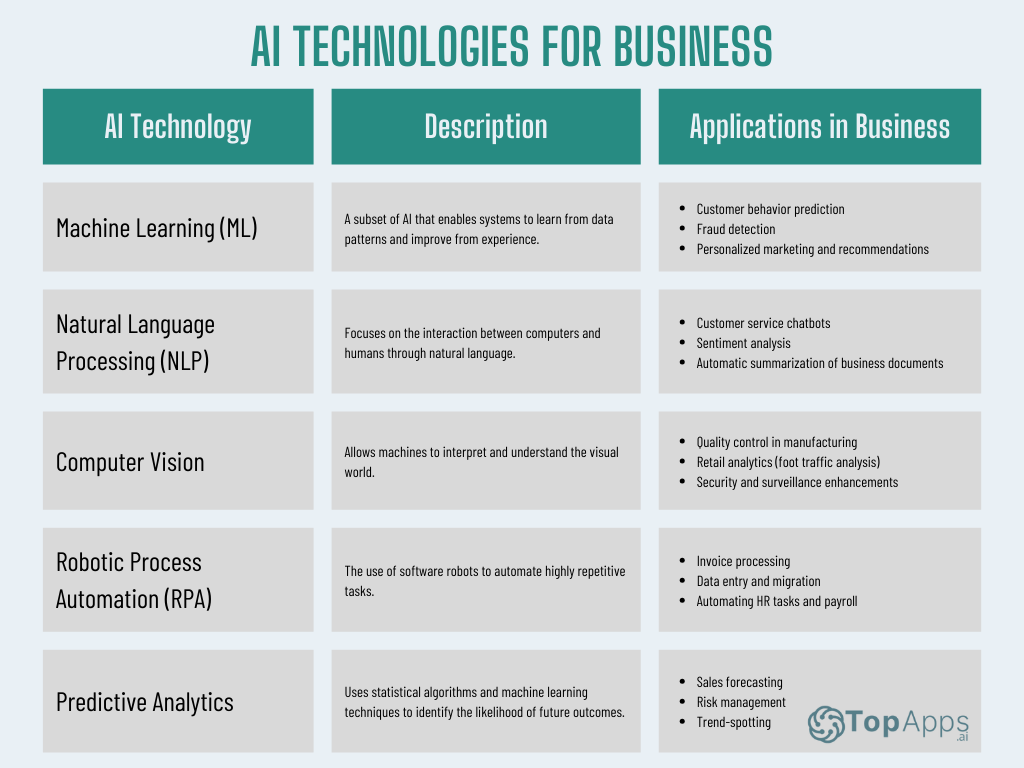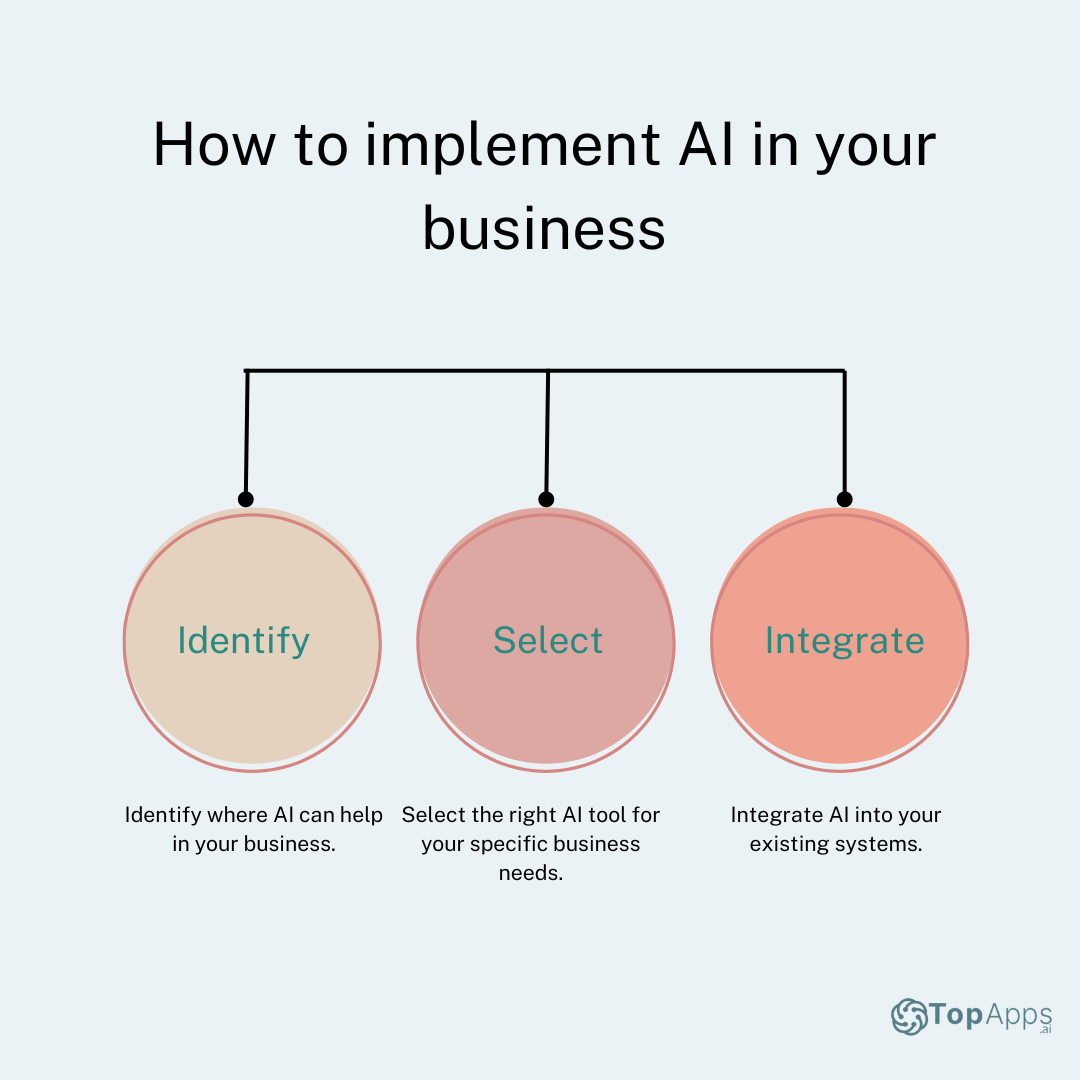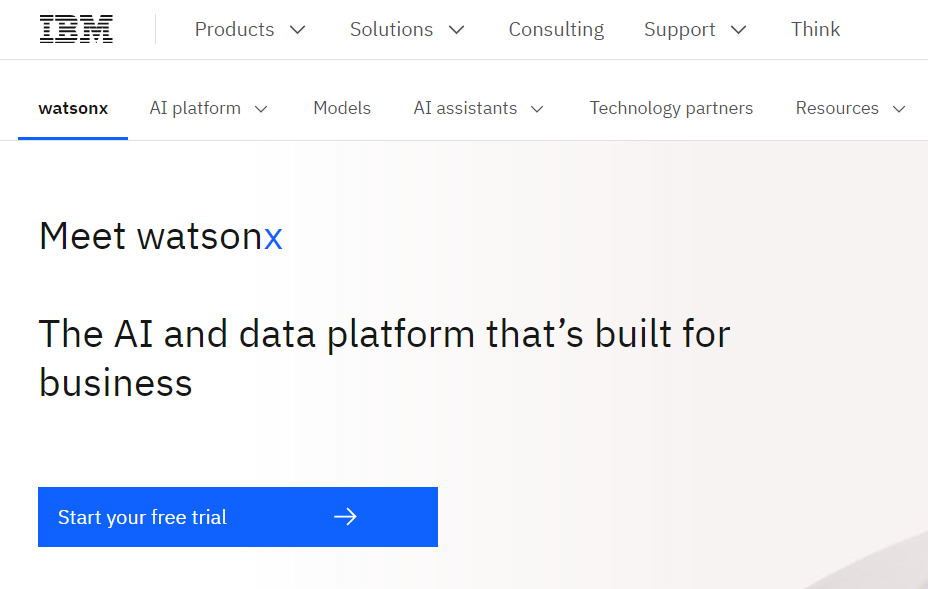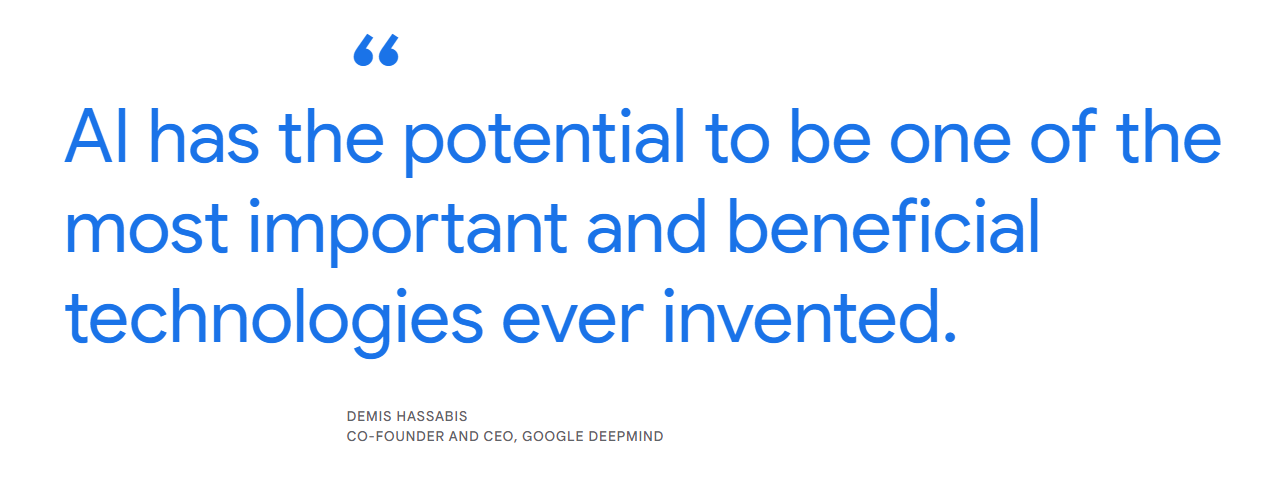Published on: April 4, 2024
AI Implementation in Business: Why It’s Not as Complicated as You Think
Author: Amy Lancelotte

Skeptical of artificial intelligence implementation in business due to perceived complexities? Here, we debunk those myths.
The notion that integrating AI into one’s business model is a Herculean task, is largely a misconception.
In reality, AI implementation in business is akin to learning an intuitive new software; challenging at first, yes, but streamlined in due course.
Packed with insights and practical advice, this article empowers you to leverage AI for business growth and efficiency.
So let’s embrace simplification over complication. Reinvent your business model, the ‘AI-way.’

Unraveling the AI implementation process
- A foolproof plan for a complex task, broken down.
- Identification of business needs, choice of AI tools, and integration challenges.
- A comprehensive blueprint for AI integration into your business.
Step 1: Identifying business needs
Every great implementation begins with understanding the problem at hand. When it comes to AI, it’s no different. Before integrating AI into your business operations, it’s crucial to pinpoint the specific needs of your business. Tailoring your AI solution to these needs ensures a result that’s as useful as possible.
Aside from addressing immediate operational needs, try to discern long-term, strategic needs. For example, do you require customer behavior predictions or automated content generation? Perform a thorough analysis of business needs to ensure the utility of your AI solution.
Next, a deep dive into how AI can fill these gaps. There are AI solutions available for a broad range of business applications, such as customer service, project management, data analysis, and much more. By understanding where your business needs lie, you create a road
Step 2: Choosing the right AI technology
Browsing through AI technologies can feel like walking down an endless supermarket aisle. It’s an ever-growing field, brimming with variety, so it’s essential to know your choices.
AI isn’t a one-size-fits-all solution. An AI model can range from machine learning algorithms and natural language processing to robotics and computer vision. Each technology could offer a unique kind of solution, and thus, it’s advisable to get a good grasp of each, and how they might benefit your business needs.
Having made sense of the specific needs and potential AI solutions, you’ll find yourself better equipped to choose the right AI technology.
Unsurprisingly, AI technology shopping involves more than just picking the shiniest tool in the shed. It requires informed decisions. A few factors can guide this selection: suitability for your business needs, ease of integration with existing systems, scalability, reliability, and of course, cost.

Step 3: Integrating AI into existing systems
The final and perhaps most labor-intensive step of AI implementation is integration into existing business systems. Count on some serious work but with a strategic plan, it can be less daunting.
AI integration isn’t about replacing your current systems lock, stock, and barrel with AI systems. Instead, it’s about molding the AI technology to work in tandem with existing infrastructure. This process might mean rearranging internal workflows, training staff to work with AI, and adjusting various components of your business to make room for the AI solution.
Each AI integration brings its own set of challenges. These can range from securing buy-in from various stakeholders and ensuring the smooth processing of data to adequately training existing staff. Despite these hurdles, the rewards of a successful AI integration far outweigh the obstacles. The key to overcoming these challenges lies in robust planning, effective change management, continuous staff education, and having a well-coordinated implementation team.
Implementing AI tools in business may seem daunting at first, but like any other significant initiative, it simplifies when broken down into manageable steps – identifying needs, picking the right technology, and implementing it into existing systems. It’s not rocket science, it’s strategic planning that transforms businesses into future-ready entities.

Maximizing the benefits of AI for your business
- Streamlining operations through AI.
- Examples of well-known businesses effectively using AI.
- Fueling business growth with AI.
Enhancing business operations by implementing AI
AI technology has the potential to greatly streamline business operations, cutting down on manual labor and facilitating efficiency across all sectors.
In most businesses where repetitive tasks are the norm, artificial intelligence can save time and money. Bots and automated systems reduce human error, enhance productivity, and allow human resources to focus more on strategic tasks. AI also excels in analyzing large volumes of data quickly and accurately, presenting insights that can inform business decisions.
AI is not restricted to a certain industry. From smart farming technologies that optimize irrigation and fertilization to medical AI that improves diagnosis accuracy, AI’s inputs are as diverse as its potential areas of application.
Real-world examples of businesses benefitting from AI
Several companies have leveraged AI to boost their productivity. For instance, Amazon uses AI to optimize its logistics, while Netflix employs AI to refine its content recommendations, enhancing user experience.
The North Face has utilized AI to transform the online shopping experience for its customers. Partnering with IBM Watson, The North Face implemented an AI-powered personal shopping assistant. Customers can interact with this virtual assistant through natural language, specifying their needs and preferences for outdoor apparel. The AI then uses this input to recommend products that best fit the customer’s requirements, taking into account factors like weather conditions, activity type, and personal preferences. This use of AI enables a highly personalized shopping experience, mimicking the level of personal attention one might get from an in-store expert, but accessible from anywhere via the company’s website.

Another example is Starbucks which has integrated AI into its operations through its Deep Brew program. One of the key applications of this initiative is the personalization of the customer experience. The AI system analyzes data from the Starbucks mobile app to offer personalized ordering suggestions to customers based on their previous orders and preferences. This not only enhances the customer experience by making ordering faster and more intuitive but also drives sales by suggesting items that customers are likely to purchase. Additionally, Starbucks uses AI for inventory management and to optimize labor allocation, ensuring that each store is staffed appropriately based on forecasted demand.

Leveraging AI for business growth
AI accelerates growth by automating tasks, refining marketing strategies, and adding value to the customer experience.
The scalability of AI makes it a crucial tool in business expansion. AI systems can be trained to handle increased data as a company grows, thus aiding in scalability. Moreover, customer service AI can handle a high volume of queries, and marketing AI can analyze vast amounts of customer data for personalized campaigns. In addition, AI can predict market trends, enabling businesses to stay competitive.
Businesses spanning various industries have harnessed AI for growth. Take the Alibaba Group for example. Alibaba uses AI for personalized recommendations, customer service (via chatbots), inventory management, and logistics optimizations. AI algorithms analyze customer data to predict buying behavior, optimize inventory levels, and improve the efficiency of Alibaba’s massive logistics network. AI has enabled Alibaba to scale its operations efficiently, manage billions of transactions, and maintain customer satisfaction, contributing to its explosive growth and dominance in the e-commerce market.
Another example is the music streaming service Spotify. It uses AI and machine learning to personalize music recommendations for its users. By analyzing listening habits, user preferences, and contextual information, Spotify’s algorithms create personalized playlists and suggest new tracks that users are likely to enjoy. Spotify’s personalized user experience, powered by AI, has been a key factor in its rapid user base expansion and its status as one of the leading music streaming services globally.
As we see, the potential of AI in enhancing business operations and aiding in growth makes it an indispensable tool for modern businesses.
Addressing common misconceptions about AI in business
- Bust the myths related to AI implementation in businesses.
- Discover how AI is cost-effective and not just for big corporates.
- See how AI complements human work and not replace it
AI is not just for big businesses
Most businesses believe AI to be a big-player game. It’s actually not. AI can benefit businesses of all sizes, not only large corporations. Even startups and small and medium enterprises (SMEs) can harness the potential of AI to streamline their operations, improve customer experiences, and make informed decisions.
For instance, small dining establishments use AI-powered apps to manage reservations, customize meal recommendations, and facilitate contactless payments. When AI is used smartly, it unlocks new avenues for business growth.
AI implementation does not have to be expensive
Even though the cost can be a hurdle when it comes to AI implementation, it doesn’t have to break the bank. Today, with a cloud-based ‘pay as you go’ model, companies can accomplish machine learning and data analytics tasks without the need for substantial upfront investment.
Moreover, businesses can prioritize their needs and start their AI journey step by step on their budget. For instance, a company can initially focus on predictive analytics that doesn’t require extensive resources and gradually move to advanced AI features as resources permit.

AI does not replace human workers
The fear of AI taking over jobs has dominated the conversation around its implementation. However, this is a misconception. While AI certainly can automate routine and mundane tasks, thereby providing efficiency, it is not a replacement for human work.
AI, in fact, augments human work. In several sectors, it performs the heavy lifting, crunching large data sets in seconds, which humans would take days to achieve. This allows workers to focus on strategic, higher-value tasks that require human skills such as creativity, leadership, and interpersonal skills.
Remember, AI and humans are not adversaries but collaborators enhancing the business landscape and maximizing those key performance indicators. It’s time businesses embrace AI and debunk unfounded misapprehensions.
Preparing your business for AI implementation
- Unleashing the power of AI in your workforce.
- The blueprint for a successful AI implementation plan.
Building an AI-ready workforce
Deploying AI technology operations does not necessitate an AI expert lurking in every corner of your business. Rather, it is about forming a workforce that appreciates the functions of AI, its application, and how it can advance daily workflow.
Upskilling your workforce for AI not only betters your AI deployment but also augments the productivity, skills, and motivation of your staff. Encouraging an AI-inclusive culture and conducting regular training on AI can equip your staff with the knowledge to effectively use artificial intelligence technology. Accustom your staff to AI by incorporating AI tools in day-to-day activities, stimulating an open mindset, and fostering a sense of adaptability.
Several online platforms offer comprehensive AI courses and seminars, providing an accessible way for your staff to get familiar with AI. Coursera, Udemy, and edX are among the leading platforms with top-notch AI courses. It’s essential to encourage your workforce to make use of these resources to upskill.
Creating an AI implementation plan
Before introducing AI to your business processes, create an AI implementation plan to ensure smooth adaptability and transition.
Start by identifying the potential areas within your business where AI can be deployed. A thorough review of your business processes helps to
A clear blueprint for AI implementation can be the difference between a successful integration and a frustrating misadventure. With clear, realistic, and measurable goals, you’re more prepared to adopt AI solutions in your business. The roadmap ensures that all stakeholders are on the same page and can pave the way for bridging necessary gaps before AI implementation.

Understanding the future of AI in business
- Predict the disruptions in future business trends due to AI.
- Learn how AI aids in post-pandemic recovery, validated through concrete case studies.
- Get ready for tomorrow by understanding how AI will reshape the future of work.
Emerging Trends in Business AI
Artificial intelligence revolutionizes every aspect of business. By offering efficiency, scalability, and precision, it’s becoming an integral part of business strategies worldwide. Innovative applications are continually sprouting, presenting new opportunities for companies to enhance their operations.
To design a successful AI-focused strategy, businesses need to understand emerging trends. They signal how AI technologies and business might interact, offering a glimpse of the competitive landscape soon. Early adopters of these trends often gain a competitive edge, attributing numerous successful ventures to their informed, forward-looking AI strategies.
AI continues to break new ground in its application within the business landscape. From AI-powered chatbots to advanced data analytics, businesses are leveraging AI in creative and strategic ways to drive growth.
Some notable AI tools include Einstein AI by Salesforce for CRM optimization, Watson Assistant by IBM for conversational interfaces, and DeepMind AI for data center cooling optimization.
Salesforce’s Einstein AI is an integrated set of AI technologies that enhances customer relationship management (CRM) tasks. It provides predictive analytics, natural language processing, and machine learning capabilities to automate tasks, predict customer behavior, and personalize customer interactions.
IBM Watson is an AI tool that allows businesses to build conversational interfaces into any application, device, or channel. Using natural language understanding and machine learning, it can interact with users in a natural way, providing information or carrying out tasks. This tool has enabled companies to enhance customer service through efficient, AI-driven chatbots and virtual assistants, reducing wait times and improving customer satisfaction.

Google’s DeepMind uses machine learning algorithms to optimize the cooling systems in data centers, reducing energy consumption significantly. It analyzes data from sensors within the data center and predicts how different adjustments affect energy usage. This application of AI has shown potential for not only reducing operational costs associated with cooling but also lowering the environmental impact of data centers, a critical concern as digital infrastructure grows.

The role of AI in post-pandemic business recovery
Shaken by the Covid-19 pandemic, businesses have (and still are) turned to AI for recovery. They’re leveraging AI to navigate the new normal, develop resilient operations, and drive recovery.
AI’s robust analytical capabilities provide businesses with comprehensive insights: understanding changing consumer behaviors, optimizing operations, devising innovative solutions, and more. It has become the linchpin in the struggle of businesses for survival, adaptation, and eventually, growth in the post-Covid terrain.
Let’s take the grocery giant Kroger as an example. The company used AI to adapt to the changing shopping habits caused by the pandemic. They implemented AI and data analytics to improve their e-commerce platform, optimize supply chain management, and implement predictive analytics to anticipate customer buying patterns. This allowed Kroger to better manage inventory, meet online order demands, and ensure the safety and convenience of their customers during a period of increased demand for online grocery shopping.
The AI-driven initiatives contributed to a significant increase in Kroger’s digital sales, which grew over 100% in the quarters following the onset of the pandemic. And this investment in AI technology helped Kroger continue to thrive post-pandemic.
AI and the future of work
As AI continues to develop, it’s also reshaping the future of work. Companies can prepare for these changes by understanding the trend predictions and preparing their workforce to work alongside AI.
AI is predicted to automate several tasks, allowing employees to focus on strategic and creative aspects. It’s also expected to introduce new job roles requiring AI specialties. Hence, understanding these predictions can empower companies to prepare ahead and seize opportunities.
Embracing the future means adapting to changes and staying ahead. Training workers in AI-related skills and embracing a culture of lifelong learning are fundamental preparation steps. To harmoniously integrate AI with the workforce, it’s also crucial to address potential concerns about job security and disruptions.
AI is no longer a distant dream. Its pervasive presence in business ecosystems is redefining ‘business as usual.’ Comprehending this evolution’s trajectory can equip businesses with the right strategies to thrive in an AI-driven future.

Demystifying implementing AI in business
So, as it turns out, AI implementation isn’t a towering nightmare. It’s about understanding your unique business needs and identifying the right AI solution tailored for them. And, of course, partnering with the right tech team.
But why does it matter so much? Well, AI promises efficiency, productivity, decision-making accuracy, and customer service enhancement for businesses willing to take the leap. It’s high time you reaped these rewards.
From here onwards, consider taking stock of your business processes that could use a helping hand from AI technologies. Engage in smart outsourcing if building in-house seems overwhelming. Reach out to trusted experts or join forums focusing on AI applications in business for continuous learning and guidance.
So, where do you see AI fitting into your business operations equation? Remember, taking the first step to implement AI today leads to progress no matter how small.
And as Nelson Mandela said, “It always seems impossible until it’s done.” Dive into the exciting world of AI for business and execute the seemingly impossible by creating business value with AI now!
Amy Lancelotte
TopApps writer
Recent Articles

Microsoft servers are down. Your business grinds to a halt. Panic sets in. Stop. Breathe. You’ve got this. This guide gives you 7...
Read More
As a business leader, you’re always searching for ways to stay ahead of the competition. What about AI in marketing and sales? In...
Read More
Struggling to keep up with the competition in 2024? You’re not alone. Small and medium enterprises (SMEs) are facing a rapidly evolving business...
Read More